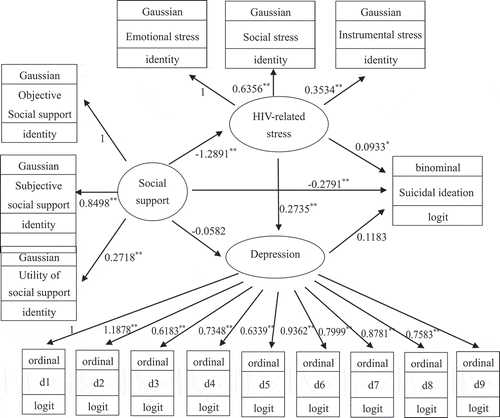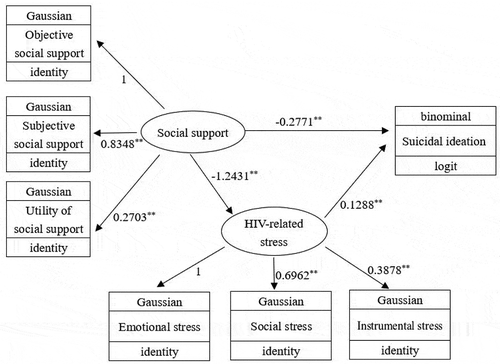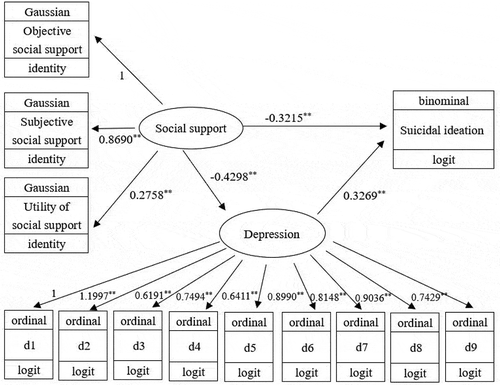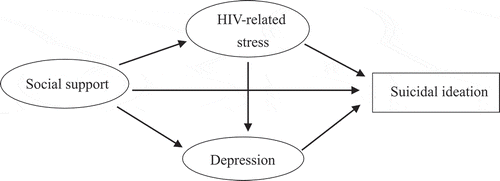ABSTRACT
Evidence have consistently shown social support to be protective against suicidal ideation among people living with HIV (PLWH), but little is known how social support protects PLHW from suicidal ideation. We aimed to explore whether social support could reduce suicidal ideation by reducing HIV-related stress levels or depression among PLWH during the early post-diagnosis phase. A cross-sectional study of 557 newly diagnosed PLWH was conducted. Information on suicidal ideation, social support, HIV-related stress and depression was collected using a self-administered questionnaire. Generalized structural equation modeling (GSEM) analyses were performed to determine the mediating effect of HIV-related stress and depression on the relationship between social support and suicidal ideation. One-fourth of participants reported considering suicide after HIV diagnosis. Higher social support could prevent PLWH from suicidal ideation directly or indirectly via reducing the HIV-related stress levels. The mediating effect of depression, as well as the chain mediating effect of HIV-related stress and depression were not found. Enhancing social support and reducing HIV-related stress are important to prevent suicide among PLWH.
Introduction
More than 3 decades into the HIV epidemic, suicide prevention among people living with HIV (PLWH) remains a priority for researchers (Catalan et al., Citation2011). Suicidal ideation has been identified as the most proximal risk factor for suicide (Klonsky et al., Citation2016), which is closely associated with the psychosocial status among PLWH (Kang et al., Citation2016).
Most individuals would suffer from a myriad of stressors after HIV diagnosis (Martinez et al., Citation2012). Greater stress has been linked with severe depression (Garrido-Hernansaiz & Alonso-Tapia, Citation2017), both of which contribute to an increased risk of suicidal ideation (O’Donnell et al., Citation2016). Social support, an established moderator, could mitigate the negative psychological consequences of stressful experiences, such as stress, depression and suicidal ideation followed HIV diagnosis (Amiya et al., Citation2014; Rzeszutek, Citation2018).
Although studies have elaborated on the relationship between these factors, issues like how social support protects PLHW from suicidal ideation, whether social support could reduce suicidal ideation by reducing HIV-related stress levels and depressive symptoms remain unclear. Identifying the interaction mechanism between these factors may provide important additional information for suicide prevention.
Therefore, this study aimed to explore the mediating role of HIV-related stress and depression on the relationship between social support and suicidal ideation among newly diagnosed PLWH. We hypothesized that higher social support: (1) has a negative direct effect on suicidal ideation; (2) has a negative indirect effect on suicidal ideation through HIV-related stress or depression; and (3) HIV-related stress and depression together have a chain mediating effect on the relationship between social support and suicidal ideation ().
Methods
Participants
From 1 March 2013 to 30 September 2014, a cross-sectional study was conducted at the Changsha Center for Disease Control and Prevention, China. PLWH were consecutively recruited if they: (a) aged ≥18 years; (b) were confirmed sero-positive within 1 month; (c) had been living in Changsha ≥6 months. The IEC of Institute of Clinical Pharmacology at Central South University approved this study (CTXY-120 033-3). All participants provided written informed consent before participation.
Measurements
Suicidal ideation
A single yes/no item was used: ‘Have you thought about suicide after HIV diagnosis?’ The answer of ‘yes’ was considered as having suicidal ideation.
Social support
Social support was measured with the Social Support Rating Scale (SSRS) (Xiao, Citation1999), including 10-item with 3 dimensions: objective social support (e.g. how much practical supports did you receive), subjective social support (e.g. how many close friends do you have), and utility of social support (e.g. what methods would you use if you are in trouble). Higher score indicates higher social support. The SSRS has been widely used in different populations, with an overall Cronbach’s α coefficient of 0.794 in PLWH (Yan et al., Citation2019).
HIV-related stress
HIV-related stress was measured with the Chinese HIV/AIDS Stress Scale (CSS-HIV) (Niu et al., Citation2016), including 3 dimensions: emotional stress, social stress, and instrumental stress. Participants were asked how much did stressors affect them in the last month. Higher score indicates greater stress levels. The CSS-HIV gives good validity and reliability, with an overall Cronbach’s α coefficient of 0.906.
Depression
Depression was measured with the 9-item Patient Health Questionnaire (PHQ-9) (Kroenke et al., Citation2001). Participants were asked the frequency of depressive symptoms in the last 2 weeks. Higher score indicates more severe depression. The PHQ-9 in PLWH shows good validity and reliability, with a Cronbach’s α coefficient of 0.780 (Monahan et al., Citation2009).
Socio-demographic and clinical information
Socio-demographic information included gender, age, residence, marital status, education, employment, individual monthly income and transmission mode. Clinical information included CD4 count and symptoms.
Data analysis
Sample characteristics were analyzed descriptively and bivariate analysis was conducted to identify factors associated with suicidal ideation. Generalized structural equation modeling (GSEM) analyses were performed to determine whether the relationship between social support and suicidal ideation was mediated by HIV-related stress and depression, after controlling the socio-demographic and clinical variables significantly associated with suicidal ideation in the bivariate analysis. Detailed introduction of the GSEM processing is available in Appendix A. All analyses were conducted in STATA MP 16.0 (Stata, Corporation Texas, USA).
Results
Psychosocial characteristics and suicidal ideation
There were 557 newly diagnosed PLWH completing this survey, with a median diagnosis duration of 13 days (interquartile ranges, IQR 10–17), of which 139 (25.0%) reported considering suicide after diagnosis (). The median score of social support was 29 (IQR 23–34), HIV-related stress 26 (IQR 15–40), and depression 7 (IQR 3–13).
Table 1. Sample characteristics of 557 participants
Bivariate analysis
Bivariate analysis showed that suicidal ideation was significantly associated with income, symptoms, social support, HIV-related stress, and depression ().
Results of GSEM
GSEM analysis showed that higher social support had a negative direct effect (SC = 0.7564, p < 0.001) on suicidal ideation () and a partly negative indirect effect (SC = – 0.1203, p < 0.01) through HIV-related stress (). However, the mediating role of depression (SC = – 0.0069, p = 0.337) and the chain mediating role of HIV-related stress and depression on the relationship between social support and suicidal ideation (SC = – 0.0417, p = 0.196) were not significant. shows the final model of GSEM.
Figure 2. Final model for associations between social support, HIV-related stress, depression and suicidal ideation among newly diagnosed PLWH (n = 557)

Table 2. Results of GSEM, direct effects (n = 557)
Table 3. Results of GSEM, indirect effects (n = 557)
Discussion
The rate of suicidal ideation among newly diagnosed PLWH in this study is much higher than that in the general population (Cao et al., Citation2015) and in PLWH with a longer duration of time since diagnosis (Malava et al., Citation2018), suggesting the importance of providing accessible mental health services for PLWH immediately after diagnosis.
As hypothesized, higher social support could prevent PLWH from suicidal ideation directly or indirectly via reducing the HIV-related stress levels. Adequate social support may help patients cope with stressful events, largely protect them from psychological distress, and thus reduce the risk of suicidal ideation (Rzeszutek, Citation2018; Tang et al., Citation2018). These finds suggest that in addition to increasing social support, reducing HIV-related stress should also be considered in suicide prevention among PLWH.
Incompatible with the hypothesis, the mediating effect of depression and chain mediating effect of HIV-related stress and depression on the relationship between social support and suicidal ideation were not significant. The mediating effect of depression was significant in the model only included depression as a mediator, but this mediating effect disappeared when HIV-related stress was simultaneously included (see Appendix A).
Once diagnosed with HIV, he/she must struggle with multiple HIV-related stressors, such as stigma, disclosure and treatment, but do not necessarily suffer from depressive symptoms such as losing interest in doing things, trouble concentrating on things or feeling bad about themselves. In a sense, PLWH may be more vulnerable to HIV-specific stressors than depressive symptoms during the early post-diagnosis phase. The HIV-related stress may be a more powerful predictor of suicidal ideation in the early stage of infection and may overshadow the effect of depression on suicidal ideation. Future research should confirm this result and explore further potential explanations.
This study has several limitations. Participants were recruited by a convenience sampling, which may limit the generalizability of results. Other psychological problems that may be also potential mediators between social support and suicidal ideation, such as anxiety and post-traumatic stress disorder, were not considered in this study. These psychological variables should be considered in future studies. Additionally, it has been about 6 years since the data collection was finished. The guideline for the treatment of HIV disease has changed over this period, from treatment at a CD4 count of ≤500 cells/mm3 in 2014, to recommending treatment immediately after diagnosis regardless of CD4 count in 2016 (National Health and Family Planning Commission, Citation2016). The psychosocial status of PLWH who were diagnosed about 6 years ago in this study may not fully reflect the status of PLWH diagnosed in recent years.
Despite these limitations, this study provides important additional information for suicide prevention among PLWH. Higher social support could prevent PLWH from suicidal ideation directly or indirectly via reducing the HIV-related stress levels. Interventions such as enhancing social support and reducing HIV-related stress may be important in the prevention of suicide among PLWH.
Ethics approval and consent to participate
This study was approved by the Human Research Ethics Committee of Central South University (CTXY-120 033-3), and all participants had provided written informed consent before participation.
Acknowledgments
We would like to express gratitude to the survey respondents and the staff of Changsha Center for Disease Control and Prevention, Changsha Hospital for Infectious Disease Hospital, and those investigators from Xiangya School of Public Health, Central South University, for their kindest contributions and assistance to this study.
Disclosure statement
No potential conflict of interest was reported by the authors.
Data availability statement
The data that support the findings of this study are available on request from the corresponding author, D L. The data are not publicly available due to their containing information that could compromise the privacy of research participants.
Additional information
Funding
References
- Amiya, R. M., Poudel, K. C., Poudel-Tandukar, K., Pandey, B. D., & Jimba, M. (2014). Perceived family support, depression, and suicidal ideation among people living with HIV/AIDS: A cross-sectional study in the Kathmandu Valley, Nepal. Plos One, 9(3), 10. https://doi.org/10.1371/journal.pone.0090959
- Cao, X. L., Zhong, B. L., Xiang, Y. T., Ungvari, G. S., Lai, K. Y. C., Chiu, H. F. K., & Caine, E. D. (2015). Prevalence of suicidal ideation and suicide attempts in the general population of China: A meta-analysis. International Journal of Psychiatry in Medicine, 49(4), 296–308. https://doi.org/10.1177/0091217415589306
- Catalan, J., Harding, R., Sibley, E., Clucas, C., Croome, N., & Sherr, L. (2011). HIV infection and mental health: Suicidal behaviour - Systematic review. Psychology Health & Medicine, 16(5), 588–611. https://doi.org/10.1080/13548506.2011.582125
- Garrido-Hernansaiz, H., & Alonso-Tapia, J. (2017). Associations among resilience, posttraumatic growth, anxiety, and depression and their prediction from stress in newly diagnosed people living with HIV. Janac-Journal of the Association of Nurses in Aids Care, 28(2), 289–294. https://doi.org/10.1016/j.jana.2016.12.005
- Kang, C. R., Bang, J. H., Cho, S. I., Kim, K. N., Lee, H. J., Ryu, B. Y., … Lee, J. K. (2016). Suicidal ideation and suicide attempts among human immunodeficiency virus-infected adults: Differences in risk factors and their implications. Aids Care-Psychological and Socio-Medical Aspects of Aids/ Hiv, 28(3), 306–313. https://doi.org/10.1080/09540121.2015.1093593
- Klonsky, E. D., May, A. M., & Saffer, B. Y. (2016). Suicide, suicide attempts, and suicidal ideation, Annu Rev Clin Psychol, 12(307–330). https://doi.org/10.1146/annurev-clinpsy-021815-093204.
- Kroenke, K., Spitzer, R. L., & Williams, J. B. W. (2001). The PHQ-9 - Validity of a brief depression severity measure. Journal of General Internal Medicine, 16(9), 606–613. https://doi.org/10.1046/j.1525-1497.2001.016009606.x
- Malava, J., Lancaster, K., Hosseinipour, M., Rosenberg, N., O’Donnell, J., Kauye, F., … Gaynes, B. (2018). Prevalence and correlates of probable depression diagnosis and suicidal ideation among patients receiving HIV care in Lilongwe, Malawi. Malawi Medical Journal: The Journal of Medical Association of Malawi, 30(4), 236–242. https://doi.org/10.4314/mmj.v30i4.5
- Martinez, J., Lemos, D., & Hosek, S. (2012). Stressors and sources of support: The perceptions and experiences of newly diagnosed Latino youth living with HIV. Aids Patient Care and Stds, 26(5), 281–290. https://doi.org/10.1089/apc.2011.0317
- Monahan, P. O., Shacham, E., Reece, M., Kroenke, K., Ong’or, W. O., Omollo, O., … Ojwang, C. (2009). Validity/reliability of PHQ-9 and PHQ-2 depression scales among adults living with HIV/AIDS in Western Kenya. Journal of General Internal Medicine, 24(2), 189–197. https://doi.org/10.1007/s11606-008-0846-z
- National Health and Family Planning Commission. (2016, June 15). Announcement on the standard of antiretroviral treatment (in Chinese). http://www.gov.cn/xinwen/2016-06/15/content_5082505.htm
- Niu, L., Qiu, Y. Y., Luo, D., Chen, X., Wang, M., Pakenham, K. I., … Xiao, S. Y. (2016). Cross-culture validation of the HIV/AIDS stress scale: The development of a revised Chinese version. Plos One, 11(4), 12. https://doi.org/10.1371/journal.pone.0152990
- O’Donnell, J. K., Gaynes, B. N., Cole, S. R., Edmonds, A., Thielman, N. M., Quinlivan, E. B., Shirey, K., Heine, A. D., Modi, R., & Pence, B. W. (2016, January). Ongoing life stressors and suicidal ideation among HIV-infected adults with depression. Journal of Affective Disorders, 190, 322–328. https://doi.org/10.1016/j.jad.2015.09.054
- Rzeszutek, M. (2018). A longitudinal analysis of posttraumatic growth and affective well-being among people living with HIV: The moderating role of received and provided social support. Plos One, 13(8), 17. https://doi.org/10.1371/journal.pone.0201641
- Tang, X., Wang, H. Y., Wang, M., Ren, X. H., Jiang, F. R., & Li, J. L. (2018, October). Structural equation modeling analysis of social support, coping strategies, depression and suicidal ideation among people living with HIV/AIDS in Changsha, China. Neuropsychiatric Disease and Treatment, 14, 2923–2930. https://doi.org/10.2147/ndt.s177460
- Xiao, S. Y. (1999). The theory basis and application of the social support rating scale. Journal of Clinical Psychiatry, 4(2), 98–100.
- Yan, H., Li, X. Y., Li, J. J., Wang, W., Yang, Y. M., Yao, X., … Li, S. Y. (2019). Association between perceived HIV stigma, social support, resilience, self-esteem, and depressive symptoms among HIV-positive men who have sex with men (MSM) in Nanjing, China. Aids Care-Psychological and Socio-Medical Aspects of Aids/ Hiv, 31(9), 1069–1076. https://doi.org/10.1080/09540121.2019.1601677
References
- Hall, R. J., Snell, A. F., & Foust, M. S. (1999). Item Parceling Strategies in SEM: Investigating the Subtle Effects of Unmodeled Secondary Constructs. Organizational Research Methods, 2(3), 233–256. doi:10.1177/109442819923002
- Nasser, F., & Wisenbaker, J. (2003). A Monte Carlo study investigating the impact of item parceling on measures of fit in confirmatory factor analysis. Educational and Psychological Measurement, 63(5), 729–757. doi:10.1177/0013164403258228
- Niu, L., Qiu, Y. Y., Luo, D., Chen, X., Wang, M., Pakenham, K. I.,… Xiao, S. Y. (2016). Cross-Culture Validation of the HIV/AIDS Stress Scale: The Development of a Revised Chinese Version. Plos One, 11(4), 12. doi:10.1371/journal.pone.0152990
- Rabe-Hesketh, S., Skrondal, A., & Pickles, A. (2004). Generalized multilevel structural equation modeling. Psychometrika, 69(2), 167–190. doi:10.1007/bf02295939
- Stata. (2016). Stata Structural Equation Modeling Reference Manual. Retrieved from https://www.stata.com/bookstore/structural-equation-modeling-reference-manual/.
- Xiao, S. Y. (1999). The theory basis and application of the social support rating scale Journal of Clinical Psychiatry, 4(2), 98–100.
Appendix A. Details of the GSEM processing
The generalized structural equation modeling (GSEM), an advantageous method exploring the mediating effect on categorical variables, was performed to determine whether the relationship between social support and suicidal ideation was mediated by HIV-related stress and depression (Rabe-Hesketh, Skrondal, & Pickles, Citation2004; Stata, Citation2016).
The item parceling method was used before the GSEM analysis, given a large number of items for the SSRS and CSS-HIV (Niu et al., Citation2016; Xiao, Citation1999). A latent construct with multiple single items may be problematic for structural equation models, such as the difficulty in making model identification and a higher likelihood of improper solutions (Hall, Snell, & Foust, Citation1999). The item parceling method has been shown to be useful in stabilizing parameter estimates and improving model fit (Hall et al., Citation1999; Nasser & Wisenbaker, Citation2003). According to the original structure of SSRS (Xiao, Citation1999) and CSS-HIV (Niu et al., Citation2016), the items of both were parceled into three indicators, respectively, and their measurement models in GSEM were analyzed using the ‘Gaussian’ family and ‘identity’ link function. Considering the PHQ-9 includes nine items with ordered answers, the ‘ordinal’ family and ‘logit’ link function were selected for the measurement model. Suicidal ideation as a binary outcome variable was fitted with ‘binominal’ family and ‘logit’ link function.
In the process of model building, we first conducted two models separately to determine whether HIV-related stress and depression mediate the relationship between social support and suicidal ideation. Model 1 included HIV-related stress as a single mediator (see and in this supplementary file) and model 2 included depression as a single mediator (see and in this supplementary file). After then, HIV-related stress and depression were entered simultaneously in the GSEM model to determine the independent mediating effects of them on the relationship between social support and suicidal ideation. Sociodemographic and clinical variables significantly associated with suicidal ideation in the bivariate analysis including individual monthly income and HIV-related symptoms were controlled as covariates in each GSEM model.
In GSEM, the effect of each independent or mediating variable on its corresponding dependent variable was shown as the standard coefficient (SC) along with the arrow line, and the further mediating effects (indirect effects) were estimated using the nonlinear combination command (nlcom) (Stata, Citation2016). The measure effects were presented as odds ratios (OR) when suicidal ideation (binary variable) was the outcome variable and were presented as β values when HIV-related stress and depression (continuous variables) were the outcome variables.
Figure A1. Model 1 for relationships between social support, HIV-related stress and suicidal ideation among newly diagnosed PLWH (n = 557)

Figure A2. Model 2 for relationships between social support, depression and suicidal ideation among newly diagnosed PLWH (n = 557)

Table A1. Results of the mediating effect of HIV-related stress on the relationship between social support and suicidal ideation (n = 557)
Table A2. Results of the mediating effect of depression on the relationship between social support and suicidal ideation (n = 557)

